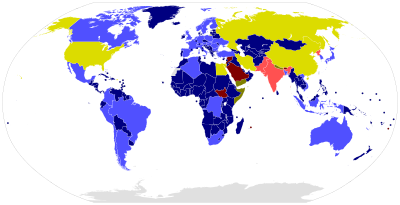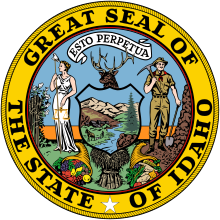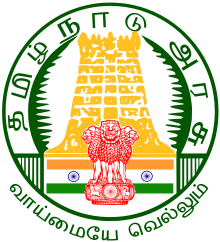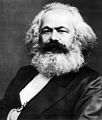Portal:Politics
| Main | Topics and categories | Tasks and projects |
The Politics portal
Politics (from Ancient Greek πολιτικά (politiká) 'affairs of the cities') is the set of activities that are associated with making decisions in groups, or other forms of power relations among individuals, such as the distribution of resources or status. The branch of social science that studies politics and government is referred to as political science.
It may be used positively in the context of a "political solution" which is compromising and non-violent, or descriptively as "the art or science of government", but also often carries a negative connotation. The concept has been defined in various ways, and different approaches have fundamentally differing views on whether it should be used extensively or in a limited way, empirically or normatively, and on whether conflict or co-operation is more essential to it.
A variety of methods are deployed in politics, which include promoting one's own political views among people, negotiation with other political subjects, making laws, and exercising internal and external force, including warfare against adversaries. Politics is exercised on a wide range of social levels, from clans and tribes of traditional societies, through modern local governments, companies and institutions up to sovereign states, to the international level.
In modern nation states, people often form political parties to represent their ideas. Members of a party often agree to take the same position on many issues and agree to support the same changes to law and the same leaders. An election is usually a competition between different parties.
A political system is a framework which defines acceptable political methods within a society. The history of political thought can be traced back to early antiquity, with seminal works such as Plato's Republic, Aristotle's Politics, Confucius's political manuscripts and Chanakya's Arthashastra. (Full article...)
Selected article
The Liberal Movement was a minor South Australian political party in the 1970s. Stemming from discontent within the ranks of the Liberal and Country League, it was organised in 1972 by former premier Steele Hall as an internal group in response to a perceived resistance to sought reform within its parent. A year later, when tensions heightened between the LCL's conservative wing and the LM, it was established in its own right as a progressive liberal party. When still part of the league, it had eleven parliamentarians; on its own, it was reduced to three. In the federal election of 1974, it succeeded in having Hall elected to the Australian Senate with a primary vote of 10 per cent in South Australia. It built upon this in the 1975 state election, gaining almost a fifth of the total vote and an additional member. However, the non-Labor parties narrowly failed to dislodge the incumbent Dunstan Labor government. That result, together with internal weaknesses, led in 1976 to the LM's being re-absorbed into the LCL, which by then had become the South Australian division of the Liberal Party of Australia. The LM and its successor parties gave voice to what is termed "small-l liberalism" in Australia.
Featured picture

George John Douglas Campbell, 8th Duke of Argyll KG, KT, PC, FRS, FRSE (30 April 1823 – 24 April 1900), styled Marquess of Lorne until 1847, was a Scottish peer, Liberal politician as well as a writer on science, religion, and the politics of the 19th century.

The governor of New York is the head of government of the U.S. state of New York, the head of the executive branch of New York's state government, and the commander-in-chief of the state's military forces. The officeholder has a duty to enforce state laws, to convene the New York State Legislature, the power to either approve or veto bills passed by the legislature, as well as to grant pardons, except in cases of treason and impeachment.
Fifty-seven people have served as state governor, four of whom served non-consecutive terms (George Clinton, DeWitt Clinton, Horatio Seymour, and Al Smith); the official numbering lists each governor only once. There has only been one female governor so far: Kathy Hochul. This numbering includes one acting governor: the lieutenant governor who filled the vacancy after the resignation of the governor, under the 1777 Constitution. The list does not include the prior colonial governors nor those who have acted as governor when the governor was out of state, such as Lieutenant Governor Timothy L. Woodruff during Theodore Roosevelt's vice presidential campaign in 1900, or Acting Speaker of the New York State Assembly Moses M. Weinstein, who acted as governor for 10 days in 1968 while the governor, the lieutenant governor and the senate majority leader were out of the state, attending the Republican National Convention in Miami. (Full article...)

The Republic of Adygea, an enclave within Krasnodar Krai located at the foothills of the Caucasus Mountains, is a federal subject of Russia. It was originally established in 1922 as the Cherkess (Adyghe) Autonomous Oblast within the Russian SFSR for the Adyghe (Circassian) majority that lived in the area. As of the 2010 Census, Adyghe people accounted for 25.2% of the republic's population (107,048 people), while Russians accounted for the majority 63.6% (270,714 people).
Since establishing and maintaining the structure of the administrative divisions of the federal subjects is not explicitly specified in the Constitution of Russia as the responsibility of the federal government, this task falls within the scope of the responsibilities of the Republic of Adygea itself. Changes to the administrative-territorial structure of the republic are authorized by the State Council. (Full article...)
The first deputy premier of the Soviet Union was the deputy head of government of the Union of Soviet Socialist Republics (USSR). Despite the title, the office was not always held by a single individual. The office bore three different titles throughout its existence: First Deputy Chairman of the Council of People's Commissars (1923–1946), First Deputy Chairman of the Council of Ministers (1946–1991), and First Deputy Prime Minister of the Soviet Union (1991). The term "first deputy premier" was used by outside commentators to describe the office of first deputy head of government.
A first deputy premier was responsible for a specific policy area. For example, Kirill Mazurov was responsible for industry, while Dmitry Polyansky was responsible for agriculture in the Soviet Union. In addition, an officeholder would be responsible for coordinating the activities of ministries, state committees, and other bodies subordinated to the government. It was expected that a First Deputy gave these organs guidance in an expeditious manner to ensure the implementation of plans for economic and social development and to check if the orders and decisions of the government were being followed. If the premier could not perform his duties one of the first deputies would take on the role of acting premier until the premier's return. During the late 1970s, when the health of Premier Alexei Kosygin deteriorated, First Deputy Premier Nikolai Tikhonov acted on his behalf as during his absence. Finally, a first deputy was by right a member of the government Presidium, its highest decision-making organ. (Full article...)
The first incumbent U.S. president to die was William Henry Harrison, on April 4, 1841, only one month after Inauguration Day. He died from complications of what at the time was believed to be pneumonia. The second American president to die in office, Zachary Taylor, died on July 9, 1850, from acute gastroenteritis. Abraham Lincoln was the first U.S. president to be killed while in office. He was shot by John Wilkes Booth on the night of April 14, 1865, and died the following morning. Sixteen years later, on July 2, 1881, James A. Garfield was shot by Charles J. Guiteau, surviving for over two months before dying on September 19, 1881. (Full article...)
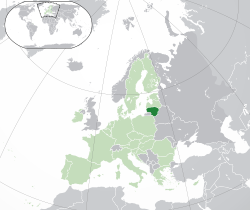
Lithuania is divided into three layers of administrative divisions. The first-level division consists of 10 counties (Lithuanian: singular – apskritis, plural – apskritys). These are sub-divided into 60 municipalities (Lithuanian: plural – savivaldybės, singular – savivaldybė), which in turn are further sub-divided into over 500 smaller groups, known as elderships (Lithuanian: plural – seniūnijos, singular – seniūnija).
At the end of its tenure as a Soviet Socialist Republic, Lithuania's administrative divisions consisted of 44 regions, 12 cities, 80 towns, 19 settlements, and 426 rural districts. The reform of this system was an immediate concern for the new government. The Constitution of Lithuania, ratified in 1992, delegated the power of establishing future administrative units to the Lithuanian Parliament (Seimas). Accordingly, the Seimas passed two fundamental laws: a 1993 law on government representation and a 1994 law specifying the territorial-administrative units and their boundaries. The current system of a set of municipalities under 10 counties was codified by 1995. Several changes were made in 2000, resulting in 60 municipalities. (Full article...)

This is a list of current members of the Senate of Canada (French: Le Sénat du Canada), the upper house of the Parliament of Canada. Unlike the members of Parliament in the House of Commons, the 105 senators are appointed by the governor general on the advice of the prime minister. Senators originally held their seats for life; however, under the British North America Act, 1965, members may not sit in the Senate after reaching the age of 75.
Seats are allocated on a regional basis: each of the four major regions receives 24 seats, with 9 remaining seats assigned to jurisdictions outside those regions. The four major regions are Ontario, Quebec, the Maritime provinces (New Brunswick, Nova Scotia and Prince Edward Island), and the Western provinces (Alberta, British Columbia, Manitoba and Saskatchewan). The seats for Newfoundland and Labrador (6), the Northwest Territories (1), Yukon (1), and Nunavut (1) are assigned apart from these regional divisions. The province of Quebec has 24 Senate divisions that are constitutionally mandated. In all other provinces, a Senate division is strictly an optional designation of the senator's own choosing, and has no real constitutional or legal standing. A senator who does not choose a special senate division is considered a senator for the province at large. (Full article...)
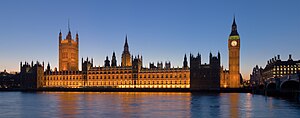
This is a list of people who have addressed both Houses of the United Kingdom Parliament at the same time. Although English and later British monarchs have jointly addressed the House of Commons and the House of Lords on several occasions since the 16th century, the first foreign dignitary to do so was French President Albert Lebrun in March 1939. The list excludes the speeches given by (or on behalf of) the Sovereign at the State Opening of Parliament and at the close of each parliamentary session.
Only four people besides the reigning monarch at the time have addressed both Houses together on more than one occasion. Nelson Mandela addressed Members of the Commons and the Lords in 1993 and in 1996 as President of South Africa. Mikhail Gorbachev addressed the Houses as a secretary of the Communist Party of the Soviet Union and a foreign delegate of the Soviet Union in 1984 and again, in 1993, on behalf of the Inter-Parliamentary Union. Shimon Peres addressed the Houses as Prime Minister of Israel in 1986 and as President in 2008. Volodymyr Zelenskyy addressed the Houses as President of Ukraine, the first to address in the Chamber (albeit via remote video link from Ukraine), in 2022 during the war in Ukraine. (Full article...)

There are 67 counties in the U.S. state of Florida, which became a territory of the U.S. in 1821 with two counties complementing the provincial divisions retained as a Spanish territory, Escambia to the west and St. Johns to the east. The two counties were divided by the Suwannee River. All of the other counties were created later from these two original counties. Florida became the 27th U.S. state in 1845, and its last county was created in 1925 with the formation of Gilchrist County from a segment of Alachua County. Florida's counties are subdivisions of the state government. Florida's most populous county is Miami-Dade County, the seventh most populous county in the nation, with a population of 2,701,767 as of the 2020 census.
In 1968, counties gained the power to develop their own charters. All but two of Florida's county seats are incorporated municipalities: the exceptions are Crawfordville, county seat of rural Wakulla County, and East Naples, located outside Naples city limits in Collier County. (Full article...)
Eight of Arizona's fifteen counties are named after various Native American groups that are resident in parts of what is now Arizona, with another (Cochise County) being named after a native leader. Four other counties, Gila County, Santa Cruz County, Pinal County, and Graham County, are named for physical features of Arizona's landscape: the Gila River, the Santa Cruz River, Pinal Peak, and Mount Graham, respectively. Another county, La Paz County, is named after a former settlement, while the final county, Greenlee County, is named after one of the state's early pioneers. (Full article...)
The governor of Idaho is the head of government of Idaho and commander-in-chief of the state's military forces. The officeholder has the duty to see state laws are executed, power to either approve or veto bills passed by the Idaho Legislature. The current governor of Idaho is Brad Little, a Republican, who took office on January 7, 2019.
Thirty-one individuals have held the office of governor of Idaho since the state's admission to the Union in 1890, two of whom served non-consecutive terms. The state's first governor, George L. Shoup, had the shortest term, of three months; Cecil Andrus had the longest, of 14 years. (Full article...)
The Chief Minister of Tamil Nadu is the chief executive of the Indian state of Tamil Nadu. In accordance with the Constitution of India, the governor is a state's de jure head, but de facto executive authority rests with the chief minister. Following elections to the Tamil Nadu Legislative Assembly, the state's governor usually invites the party (or coalition) with a majority of seats to form the government. The governor appoints the chief minister, whose council of ministers are collectively responsible to the assembly. Given that he has the confidence of the assembly, the chief minister's term is for five years and is subject to no term limits.
Since 1950, Tamil Nadu has had 12 chief ministers, 13 including V. R. Nedunchezhiyan, who twice acted in the role. The longest-serving chief minister, M. Karunanidhi from Dravida Munnetra Kazhagam held the office for over eighteen years in multiple tenures, while he was the one who had the largest gap between two terms (nearly thirteen years). The All India Anna Dravida Munnetra Kazhagam's former general secretary J. Jayalalithaa has the second-longest tenure, and its founder M. G. Ramachandran, the first actor to become the chief minister in India has the third-longest tenure, while his wife V. N. Janaki Ramachandran has the shortest tenure (only 23 days). K. Kamaraj resigned his post of his own free will and devoted all of his energy to the revitalization of the Indian National Congress party; he was responsible for the elevation of Lal Bahadur Shastri to the position of Prime Minister of the Republic of India following the death of Jawaharlal Nehru and of Indira Gandhi following the death of Lal Bahadur Shastri. C. Rajagopalachari served as the last Governor-General of the Union of India before becoming chief minister of undivided Madras State. There have been four instances of president's rule in Tamil Nadu, most recently in 1991. (Full article...)
- Lower Canada held 15 elections for its Legislative Assembly, from 1792 to 1835;
- Upper Canada held 13 elections to its Legislative Assembly, from 1792 to 1836;
- the Province of Canada held 8 elections for its Legislative Assembly from 1841 to 1863;
- New Brunswick's first 21 elections, beginning in 1785 (the 21st Legislative Assembly of New Brunswick was elected in 1866, one year before Confederation, and continued until 1870, three years after Confederation);
- Nova Scotia's first 22 elections, beginning in 1758;
- Prince Edward Island's first 25 elections, beginning in 1773; and
- Newfoundland's first 29 elections, beginning in 1832.
The most recent election is shown with a box limited to five years of government, as this is the maximum length of office, as set by the constitution. However, elections can be called at any time by an incumbent government. The federal government, nine provinces, and one territory have changed to fixed election dates every four years. For these legislatures, the box is shown as running until the next scheduled election, but one could still be earlier if the government falls due to a motion of no confidence. Nova Scotia and Yukon do not have fixed election dates in this matter. (Full article...)

Jesus College is one of the constituent colleges of the University of Oxford in England. The college was founded in 1571 by Queen Elizabeth I at the request of Hugh Price, a Welsh clergyman, who was Treasurer of St David's Cathedral in Pembrokeshire. The college still has strong links with Wales, and about 15% of students are Welsh. There are 340 undergraduates and 190 students carrying out postgraduate studies. Women have been admitted since 1974, when the college was one of the first five men's colleges to become co-educational. Old members of Jesus College are sometimes known as "Jesubites".
Harold Wilson studied at Jesus College from 1934 to 1937, and was later the Prime Minister of the United Kingdom during two periods (from October 1964 to June 1970, and from March 1974 to April 1976). More than 30 other Members of Parliament (MPs) have been educated at the college, from Sir John Salusbury who was elected as MP for Denbighshire in 1601 to Theresa Villiers who was elected as MP for Chipping Barnet in 2005. Sir Leoline Jenkins, who became a Fellow and later the Principal of the college, was Secretary of State for the Northern Department from 1680 to 1681 and Secretary of State for the Southern Department from 1681 to 1685. Sir William Williams served as Speaker of the House of Commons from 1680 to 1685 and as Solicitor General for England and Wales from 1687 to 1689. Evan Cotton was MP for Finsbury East before holding the position of President of the Bengal Legislative Council from 1922 to 1925. Several Welsh politicians have been educated at the college, some representing constituencies in Wales (such as Sir John Wogan, representing Pembrokeshire at various times between 1614 and 1644) and others working outside Parliament, such as D. J. Williams, a co-founder of the Welsh nationalist party Plaid Cymru. (Full article...)
The Mayor of Pichilemu is an elected politician who is the head of the executive branch of government of the commune of Pichilemu, Libertador General Bernardo O'Higgins Region, Chile. The mayor presides over the local city council, composed of six members, and serves as the civic representative of the commune. The mayor is popularly elected in a municipal election, by simple majority. The office is held for a four-year term without term limits.
Forty different individuals, including acting mayors, have held the office of mayor since the commune of Pichilemu was created in December 1891. José María Caro Martínez, elected in 1894, was the inaugural mayor of the commune, and served for almost four consecutive terms, interrupted by his resignation in 1905. The current mayor is independent Cristian Pozo Parraguez, who was elected in May 2021 and took office on that 28 June. (Full article...)
Selected quote
Selected biography
Rebeca Elvira Delgado Burgoa (born 1 June 1966) is a Bolivian academic, lawyer, magistrate, and politician who served as president of the Chamber of Deputies from 2012 to 2013. As a member of the Movement for Socialism, she served as a party-list member of the Chamber of Deputies from Cochabamba from 2010 to 2014. Prior to her election to the lower chamber, Delgado served as a party-list member of the Constituent Assembly from Cochabamba from 2006 to 2007 and was vice minister of government coordination from 2008 to 2009. Delgado's near-decade-long political and legislative tenure was preceded by a fifteen-year career as a public servant, during which time she worked as a public defender and examining magistrate, was a magistrate on the Departmental Electoral Court of Cochabamba, and served as the Ombudsman's Office's delegate for the fight against corruption in Cochabamba.
Did you know (auto-generated) -

- ... that American journalist and activist Clara Leiser traveled to Nazi Germany frequently, and documented the plight of families of political prisoners?
- ... that no single political party has a mandate in a coalition government?
- ... that the party leader of the new Dutch youth political party LEF – For the New Generation tattooed his party's program points on his forearm?
- ... that Nobel laureate Thomas Mann reportedly did not want his Reflections of a Nonpolitical Man to be translated into English during his lifetime due to its chauvinistic content?
- ... that Liz Shore's nomination to be Chief Medical Officer of the United Kingdom was vetoed by Margaret Thatcher because of Shore's husband's political affiliation?
- ... that Dave Barrow quit municipal politics to work at his family's insurance brokerage before becoming mayor of Richmond Hill?
More did you know...
- ...that the public activist group Citizen Action shut down in 1997 due to the effects of a labor union election campaign funds scandal?
- ...that Mussolini's Quota 90 fixed the lira exchange rate against the pound sterling at the prevailing rate from five years earlier, when he assumed power?
- ...that the energy lobby contributed 19 million dollars to United States political campaigns in the 2006 election cycle?
- ...that the lifelong Democrat Jim Naugle is in his sixth straight term as the Mayor of Fort Lauderdale and supported only Republicans for President since 1968?
- ...that co-founder of the Saudi Civil and Political Rights Association Mohammed al-Bejadi spent most of 2011 in prison?
- ...that when the Tennessee Center for Policy Research, a "free-market think tank," criticized Al Gore's energy use, CNN mistakenly called the organization an environmental group?
In this month
- May 5, 2005 – A General Election in the United Kingdom sees Tony Blair's Labour government returned to office with a reduced majority of 66.
- May 14, 1948 – The Declaration of Independence of Israel is made.
- May 18, 1948 – The first Legislative Yuan of the Republic of China officially convenes in Nanking.
News and Current events
- August 11: 4 local government areas in New South Wales, Australia locked down after COVID-19 case
- August 11: Australia: AstraZeneca vaccine access expanded by Victorian government
- August 1: Australia: Victorian lockdown lifted
- July 29: Tunisia's president dismisses prime minister, suspends parliament
- July 25: Australia: Wikinews interviews Reg Kidd, mayor of the City of Orange, about COVID-19 lockdown and local government
- July 23: South Australia enters week-long lockdown to contain COVID-19 Delta variant spread
- July 21: Technological University Dublin senior lecturer Dr Lorcan Sirr speaks to Wikinews on housing market in Ireland
- July 21: Three rural councils in New South Wales, Australia enter 7-day lockdown
- July 21: Australia: Victoria lockdown extended by a week with 85 active cases recorded
- July 15: California governor signs new state budget, eligible Californians to get stimulus payments
Topics and categories
General images
Related portals
Associated Wikimedia
The following Wikimedia Foundation sister projects provide more on this subject:
-
Commons
Free media repository -
Wikibooks
Free textbooks and manuals -
Wikidata
Free knowledge base -
Wikinews
Free-content news -
Wikiquote
Collection of quotations -
Wikisource
Free-content library -
Wikiversity
Free learning tools -
Wiktionary
Dictionary and thesaurus


